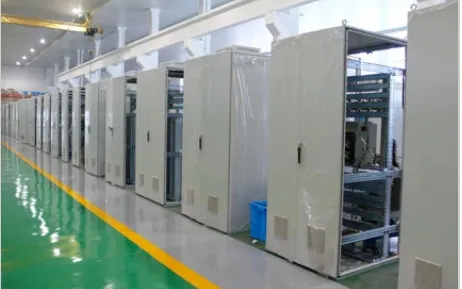
AGC in Hot Rolling Mills: Challenges and Solutions
The implementation of automatic gauge control system (AGC) technology in hot rolling mills represents a significant advancement in steel production, yet presents unique challenges compared to cold rolling applications. While Contrôle automatique de l'écartement dans le laminage de bandes has become well-established in cold mills, the high-temperature environment and dynamic conditions of hot rolling require specialized approaches to thickness control. Modern laminoir à froid à contrôle automatique de calibre technologies have been adapted for hot operations, but with critical modifications to account for thermal expansion, scale formation, and rapid material property changes. This article examines the specific difficulties of implementing Systèmes AGC in hot rolling mills and explores innovative solutions being developed by manufacturers and process engineers.

Fundamental Differences Between Hot and Cold Rolling AGC
The core principles of contrôle automatique de la jauge hydraulique remain similar across rolling processes, but hot rolling introduces variables that demand enhanced system capabilities. The AGC controller in a hot mill must compensate for several factors absent in cold rolling: thermal expansion of rolls, inconsistent material flow stress due to temperature gradients, and the presence of scale on the workpiece surface. Unlike the stable conditions of a laminoir à froid à contrôle automatique de calibre, hot rolling operations experience continuous thermal fluctuations that affect both the mill stand stiffness and the deformation resistance of the steel being rolled.
Thermal Challenges in Hot Rolling AGC Implementation
The high temperatures in hot rolling mills create persistent obstacles for contrôle automatique de la pression systems. Roll thermal crown—the hourglass shape developed due to uneven heating—can vary significantly during a campaign, requiring continuous adjustment of the Système AGC to maintain consistent strip profile. The contrôle automatique de la jauge hydraulique must therefore incorporate thermal models that predict roll expansion patterns and adjust rolling force compensation accordingly. Modern systems integrate infrared temperature sensors with advanced algorithms to provide real-time thermal compensation, a feature less critical in Contrôle automatique de l'écartement dans le laminage de bandes for cold applications.
Material Behavior and Its Impact on AGC Performance
The dynamic metallurgical transformations occurring during hot rolling present unique challenges for AGC controllers. Unlike cold rolling where material properties remain relatively constant, hot rolled steel exhibits varying flow stress characteristics depending on temperature, strain rate, and phase transformations. The automatic gauge control system must therefore adapt to these changing material properties throughout the length of each coil. Advanced systems now incorporate microstructural prediction models that adjust rolling force parameters based on anticipated changes in austenite grain size and recrystallization behavior, providing more accurate gauge control than traditional force-based Systèmes AGC.
Mill Stiffness Variations in Hot Rolling AGC
The structural dynamics of hot rolling mills present additional complications for contrôle automatique de la pression systems. The significant thermal expansion of mill components—including housings, chocks, and screws—alters the mill's elastic modulus during operation. A robust AGC controller for hot applications must continuously update its mill stretch coefficients to maintain accuracy. Some systems now employ dynamic stiffness measurement techniques using specialized load cells and position sensors to provide real-time stiffness compensation, a feature less critical in Contrôle automatique de l'écartement dans le laminage de bandes for cold applications where thermal effects are minimal.
Advanced Control Strategies for Hot Rolling AGC
To overcome these challenges, modern automatic gauge control systems for hot rolling employ sophisticated control architectures. Model-based predictive control (MPC) has proven particularly effective, using physical models of the rolling process to anticipate and compensate for gauge variations before they occur. These systems integrate with contrôle automatique de la jauge hydraulique actuators to provide both fast response to immediate disturbances and long-term compensation for gradual changes like roll wear. Adaptive learning algorithms continuously update control parameters based on process history, improving performance over time—a crucial capability given the variability inherent in hot rolling operations.
The implementation of automatic gauge control system technology in hot rolling mills represents a complex engineering challenge, requiring solutions that go beyond those used in laminoir à froid à contrôle automatique de calibre applications. While the fundamental principles of contrôle automatique de la jauge hydraulique remain applicable, the high-temperature environment, material transformations, and measurement difficulties demand specialized approaches.
Moderne AGC controllers for hot rolling combine advanced sensing technologies, sophisticated control algorithms, and comprehensive system integration to deliver consistent gauge control despite the challenging conditions. As steel producers face increasing demands for tighter tolerances and improved product consistency, continued innovation in automatic gauge control in hot rolling will remain essential for maintaining competitiveness in the global steel market.
-
Indian Clients Visit YWLX to Inspect Skin-pass MillNouvellesJun.22,2025
-
Typical Products from Reversing Cold Rolling ProcessNouvellesMay.26,2025
-
Surface Finish Improvement through Skin Pass RollingNouvellesMay.26,2025
-
Integration of AGC Systems in Modern Cold Rolling MillsNouvellesMay.26,2025
-
Cold Rolling in the Context of High-Strength Steel DemandNouvellesMay.26,2025
-
Why Reversing Cold Rolling Mills Are Ideal for Specialty MetalsNouvellesMay.13,2025
-
The Pivotal Position of Hot Rolling Mills in the Iron and Steel Industry ChainNouvellesMay.13,2025










